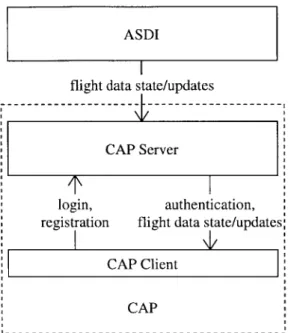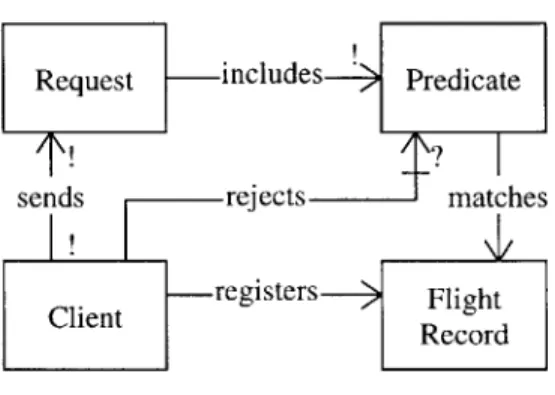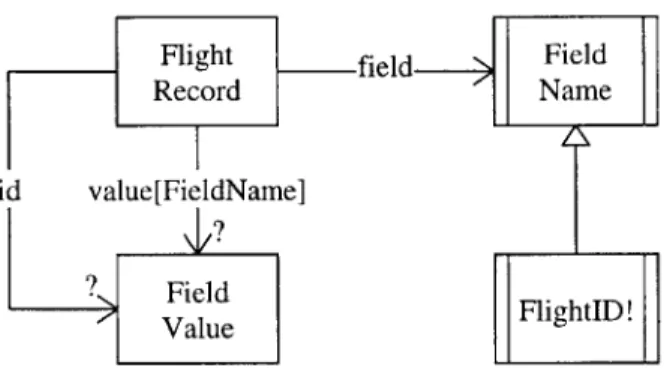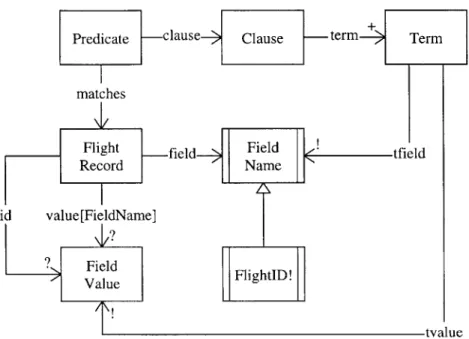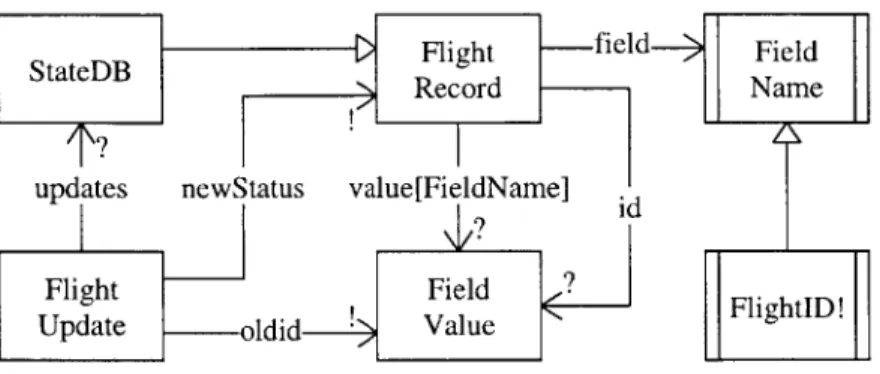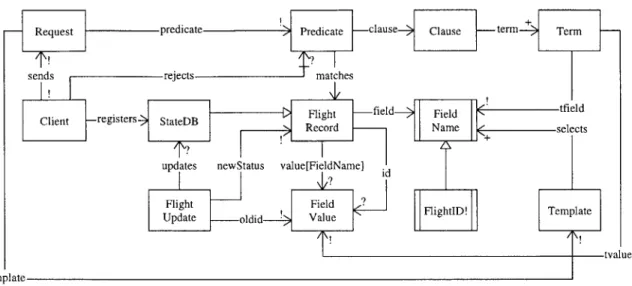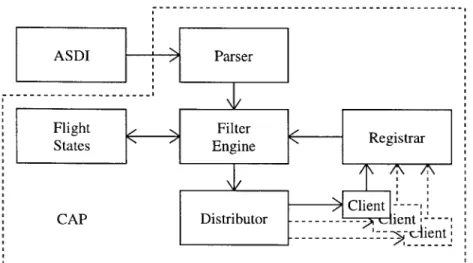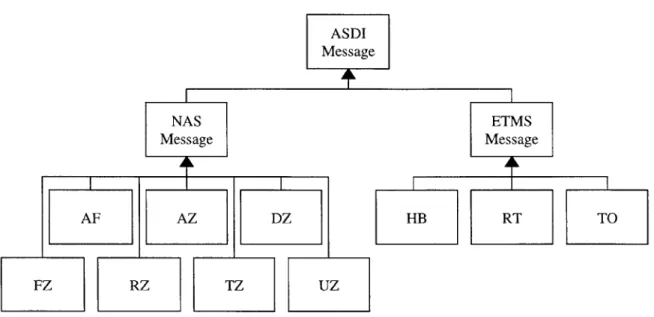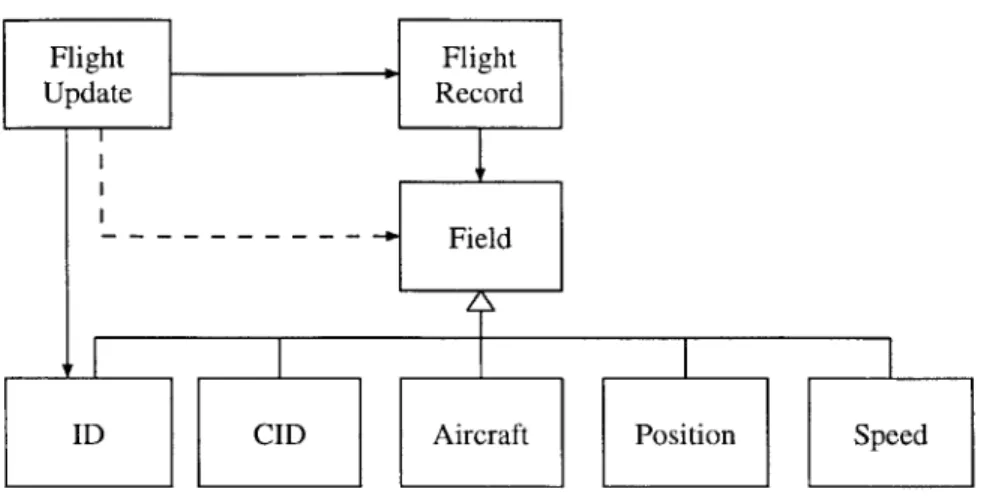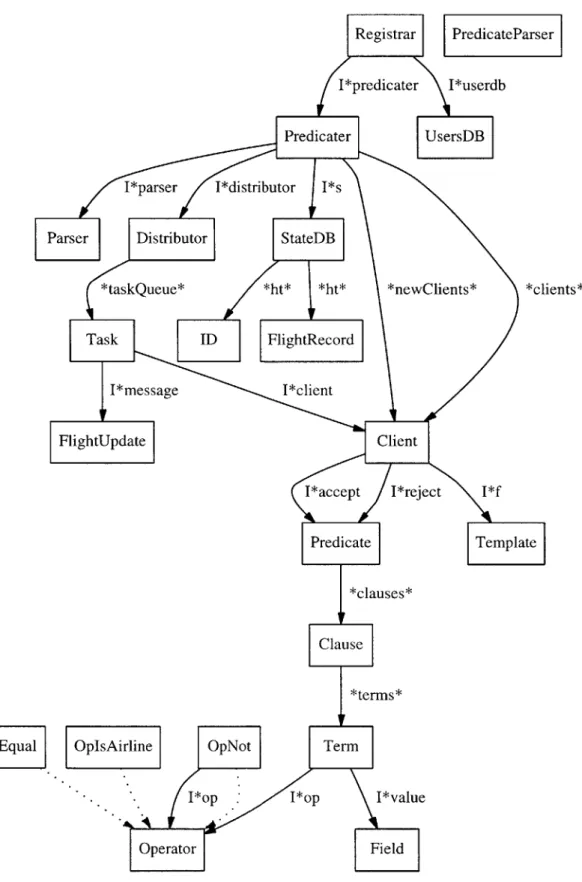Collaborative Arrival Planner:
Its Design and Analysis Using Object Modelling
by
David C. Zhang
Submitted to the Department of Electrical Engineering and Computer
Science
in partial fulfillment of the requirements for the degrees of
Master of Engineering in Electrical Engineering and Computer
Science
and
Bachelor of Science in Computer Science and Engineering
at the
MASSACHUSETTS INSTITUTE OF TECHNOLOGY
May 2000
@
David C. Zhang, MM. All rights reserved.
The author hereby grants to MIT permission to reproduce and
distribute publicly paper and electronic copies of this thesis document
!t-in whole or !t-in part.
A uthor ...
ASSAMSCHUSET TS INSTITUTE FT ECHNOLOGYJUL 2 7 2000
... LIBRARIESDepartment of Electrical Engineering and Computer Science
May 18, 2000
Certified by
. . . .Daniel Jackson
Associate Professor
Thesis Supervisor
Accepted by ...
Arthur C. Smith
Chairman, Department Committee on Graduate Students
Collaborative Arrival Planner:
Its Design and Analysis Using Object Modelling
by
David C. Zhang
Submitted to the Department of Electrical Engineering and Computer Science on May 18, 2000, in partial fulfillment of the
requirements for the degrees of
Master of Engineering in Electrical Engineering and Computer Science and
Bachelor of Science in Computer Science and Engineering
Abstract
This thesis describes the design, analysis, and implementation of a client/server ar-chitecture for an infrastructural software system. The system designed is a prototype of the Collaborative Arrival Planner (CAP), a new component being considered by NASA to aid the exchange of information between the Center/TRACON Automation System (CTAS) and external parties.
The CAP server receives continuous flight status information from a feed provided by the Volpe National Transportation Center. For the clients, the CAP server provides predicated filtering, a method by which the clients can specify relevance of certain flights, and receive only those flight information from the server.
Alloy, an object modelling language similar to UML and Z, and its analysis tool Alcoa were used to aid the design and analysis of the CAP prototype. Critical portions of the CAP architecture was modeled in Alloy. These models were analyzed in Alcoa to find flaws, and validate properties of the design. We use CAP as an example of infrastructural software, and show that object modelling techniques can be efficiently applied to help the design and analysis of real world software systems.
Thesis Supervisor: Daniel Jackson Title: Associate Professor
Acknowledgments
Many people contributed to this thesis project. I would like to thank my advisor Professor Jackson for teaching me the way of object modelling; Professor Gifford for his insights on predicated filtering; and Qian Wang for his help on the implementation and understanding the ASDI feed.
To Christine, thanks for always believing in me.
I dedicate this work to my family. Dad, thanks for all the advice you have given me. I hope you never stop giving them. Mom, thanks for showing me how to be strong. Jane, thanks for always watching out for me.
Contents
1 Introduction 10 1.1 Background . . . .. 11 1.2 Problem Statement . . . . 12 1.3 Motivation. . . . . .. 14 2 Functionality 15 2.1 Authentication . . . . 16 2.2 Predication . . . .. 17 2.3 Templates . . . .. . .. . . 17 2.4 Persistence . . . .. . . .. 193 Design and Analysis 20 3.1 Registration . . . . 20 3.2 Flight Record . . . . 24 3.3 Predicate Matching . . . . 25 3.4 Template . . . . 27 3.5 State Database . . . . 31 3.6 Flight ID Amendment . . . . 32
3.6.1 Templates and Flight ID Amendment . . . . 32
3.6.2 State Database and Flight ID Amendment . . . . 34
3.7 Summary . . . . 37
4 Implementation 39
. . . . 4 0 4.1.1 Flight Update . . . . 44 4.2 Registrar . . . . 44 4.2.1 Predicate Operators . . . . 45 4.2.2 User Database. . . . . 46 4.3 Filter Engine . . . . 46 4.3.1 Update Database . . . . 48 4.3.2 Predicate Matching . . . . 48 4.3.3 Apply Template. . . . . 49
4.3.4 New Client Connections . . . . 49
4.4 Flight State Database . . . . 50
4.5 Distributor . . . . 51 5 Conclusion 52 5.1 Object Modelling . . . . 52 5.2 Design Review . . . . 53 5.3 Extensions . . . . 54 A Alloy Models 56 A.1 Registration . . . . 56
A.2 Flight Record . . . . 57
A.3 Predicate . . . . 58
A.4 Flight Update . . . . 59
A.5 Template . . . . 60
A.6 State Database . . . . 62
B Code Object Models 64 C Module Dependency Diagrams 67 D Code 71 D.1 Server.java . . . .. 71 4.1 Parser
D.2 DumbClient.java . . . . 74 D.3 distributor package . . . . 76 D.4 parser package . . . . 78 D.5 predicater package . . . . 100 D.6 registrar package . . . . 109 D.7 util package . . . . 118 D.8 xml package . . . . 127
List of Figures
2-1 Data Flow Paths in CAP . . . . 16
3-1 Model describing Registration and Policy . . . . 21
3-2 Model for Flight Record Data Structure . . . . 23
3-3 Model Relating Predicate and Flight Record . . . . 25
3-4 Model for Predicate Matching with Naive Matching Method . . . . . 26
3-5 Model for Templates that Violates Flight Record Invariant . . . . 28
3-6 Partial Model for Flight Database Operations . . . . 30
3-7 Partial Model for Flight Updates and Templates . . . . 33
3-8 Model for Flight Update . . . . 34
3-9 Partial Model for Flight Updates and State Database . . . . 35
3-10 Complete Object Model for CAP . . . . 37
4-1 CAP Components and Data Flow Paths . . . . 40
4-2 ASDI Message Hierarchy . . . . 41
4-3 Flight Update and Flight Record MDD . . . . 43
4-4 User Database Format . . . . 46 B-1 CAP Components . . . .
B-2 Flight Record Fields . . . . C-1 CAP Component Dependencies . C-2 CAP Server Modules . . . . C-3 Flight Record and Fields . . . . . C-4 Parser Modules . . . . 65 66 67 68 69 69
C-5 Distributor Modules . . . . 69 C-6 Predicater Modules . . . . 70 C-7 Registrar Modules . . . . 70
List of Tables
4.1 ASDI M essage Types . . . . 41
4.2 Flight Record Fields and Field Types . . . . 43 4.3 Field Types and Operators . . . . 47
Chapter 1
Introduction
The Collaborative Arrival Planner (CAP) is an intermediate software module to aid the exchange of information between the Center/TRACON Automation System (CTAS) and external parties (e.g. airlines, FAA, researchers). The architecture of CAP was designed and analyzed using Alloy, an object modelling language that has precise semantics so its models are analyzable by software. A prototype of CAP was implemented using the Java programming language.
This chapter briefly describes the backgrounds on CTAS, CAP and Alloy, then sets the scope of this thesis.
Chapter 2 describes the functionalities provided by the CAP server, and its rela-tion with ASDI.
Chapter 3 describes the design of the CAP using object modelling notations from the language Alloy, along with analysis of the design.
Chapter 4 describes the architecture of the prototype implementation of CAP that we developed, and its fulfillment of the design.
Chapter 5 concludes this paper by describing the experience of developing CAP using object modelling techniques, reviews the design and the decisions made, and mentions some extensions to CAP that are being considered.
1.1
Background
The first goal of air traffic control is to prevent collision by maintaining safe separa-tions among aircrafts. Separation is provided by establishing approved longitudinal, lateral, or vertical distance between aircrafts. This is no easy task near large airports, where there are frequent landings and take-offs, and the concentration of aircrafts is dense.
The second goal of air traffic control is to make efficient use of the air space without sacrificing the first goal. In many countries including the United States, the rate at which aircraft can land at airports is the limiting factor in air traffic flow [DEGN91]. The Center/TRACON Automation System (CTAS) is a suite of air traffic control decision-support tools developed by NASA Ames Research Center to help air traffic controllers to manage air traffic flows efficiently.
The purpose of CTAS is to increase the landing rate at large airports. On a high level, CTAS receives aircraft arrival data that are within the Center or TRACON air space, along with other considerations such as weather conditions, airport configura-tions, and outputs a sequence of scheduling recommendations to air traffic controllers. After demonstrating a 10% improvement in the sustained landing rate at Dallas/Fort Worth (DFW), CTAS has been selected by the FAA for national deployment.
The Collaborative Arrival Planner (CAP) is a software system currently under development, to aid the exchange of information between CTAS and external parties such as airlines and FAA. The goal of CAP is to prevent arrival timing miscues by facilitating communication of arrival information between CTAS and airlines, conse-quently increasing airline efficiencies.
The preliminary requirements for CAP are described in more detail in [Fan]. In brief, CAP provides two major functions. First, it serves as a intermediary to facilitate communication between CTAS and airline dispatchers. CAP provides flight arrival information from CTAS to airline personnel, and accepts rescheduling requests back from airlines.
CTAS installations. Currently CTAS installations are isolated from each other, but their functionalities can be improved by obtaining air traffic predictions from the sur-rounding Centers. By creating a network of CTAS using CAP, each CTAS can obtain more accurate predictions of flight status and thereby make better recommendations to the controllers.
The design of CTAS was the focus of a study in software design by the Software Design Group in the MIT Lab for Computer Science [JCOO]. In this study, Daniel Jackson and others took apart CTAS, and make it dramatically simpler by using a number of software engineering techniques. These traditional techniques were so effective, that they did not employ advanced techniques such as object modelling. This thesis is a follow-on to the CTAS redesign project. Instead of re-engineering a system like CTAS, We apply object modelling techniques right from the start of the design of CAP. Our motivation is discussed later in this chapter.
1.2
Problem Statement
The use of CAP to network CTAS installations is not within the scope of this project, as we believe it requires a completely orthogonal design from its first functionality. CAP's two functional requirements are better served by separate systems, because the combination of the two functionality in a single system leads to undesirable level of complexity.
The focus of this paper is on a preliminary design of CAP limited to providing filtered flight information from CTAS to airlines, and related issues such as authen-tication, registration, and distribution. While this is a limited design, it serves as a basis for additional functionality in the future.
The problem, now redefined, is to design and implement a prototype system for efficient distribution of real-time flight information to relevant clients, where relevance is specified by the client. Irrelevant flight information are filtered out by the server, and never sent to the client. So bandwidth is used efficiently. In addition, the system should be flexible in supporting definition of relevance by the client. For example, a
client should be able to specify a region of air space, then receive flight information on all flights entering and leaving that space.
We have many possible applications in mind for this system. Air traffic controllers can use it for monitoring the flights arriving at or leaving an airport. Researchers can record real flight traffic data for their studies, and avoid the task of filtering the data themselves. Displaying flight routes of several airlines is also a convenient application. Instead of receiving data from CTAS installations, our prototype system will be using the Aircraft Situation Display To Industry (ASDI) data feed from the Volpe Center as the source for flight information. The ASDI feed provides real-time air traf-fic data from the National Airspace System (NAS), which includes flight plans, routes, positional and status information. This feed provides data similar to that needed by CAP, and is easily accessible by members of the aviation industry. Technical details of the ASDI feed can be found in [Vol99].
Take note that the data sent over the ASDI feed has been filtered. For example, military flights and other sensitive flights (such as flights of the Drug Enforcement Agency) are removed from the data stream; also, messages from certain facilities are sometimes removed. Consult the reference [Vol99], section 3.1, for more information on the filtering process.
We implement a prototype of this system using the Java programming language. We also use the object modelling language Alloy and its companion analysis tool
Alcoa, to design and analyze the architecture of CAP.
Alloy is a lightweight, precise and tractable notation for object modelling [Jac99]. It is lightweight because it has a simple and small syntax that is expressive enough for most object modelling problems. It is precise because the semantics of the language is based on sets and relations. It is tractable so its models can be efficiently and fully analyzed semantically. Alloy is influenced by the modelling language UML and the specification language Z.
Alcoa is a tool for analyzing object models written in Alloy [DanOO]. It works by translating the constraints of a model to boolean formulas, and then applying a SAT (satisfiability) solver to check the satisfaction of the original constraints. Using the
solution of the solver, Alcoa can output instances of the model that satisfy a set of constraints, or counter-examples that violate some constraints.
1.3
Motivation
There are two motivations behind this thesis. The first one is practical. The collabo-rative arrival planner is a real system being considered by NASA as a part of a major effort to upgrade and modernize the air traffic control system in the U.S. With this thesis, we help design the architecture of CAP and provide a prototype with majority of the functionality.
The second one is to evaluate the methodology of software design assisted by an object modelling language that is checkable. Software systems are being used in more and more aspects of our lives, such as banking, utility, and traffic control. These infrastructural software systems are large and complex. Their designs are difficult and time consuming using traditional techniques. Their implementation stages are often plagued by discovery details not accounted for in the initial design, thus delaying delivery and increasing cost.
Alloy and Alcoa are designed together to help tackling these problems from the design stage. Alloy provides a precise language for expressing designs and specifying their behavior. Alcoa is a model checker that can find flaws in Alloy models. Together, they have been used to analyze several existing designs of software systems in different domains. But they have not been used in formulating the design of a new system. With this thesis, we wish to demonstrate, by using CAP as an example, that an object modelling language such as Alloy can be easily applied to real world system design. Object modelling techniques, combined with static analysis at the semantic level, improves traditional software methods.
Chapter 2
Functionality
This chapter describes the functionalities provided by the CAP server, and its relation with the Aircraft Situation Display To Industry (ASDI).
CAP uses a client-server model that is common to many infrastructural software systems today, as shown in Figure 2-1. The input to CAP is the ASDI flight informa-tion feed. From ASDI, CAP receives actual and projected status informainforma-tion about
all flights in the United States. The ASDI feed is incremental, its update messages only contain updated parts flight status, unchanged parts of the flight status are left out (except for the flight identifier, which is needed to distinguishes the messages).
CAP server parses that information and then forwards that information to all interested clients. CAP differs from traditional client-server relationship by providing streaming data that is highly customized to fit each client's need. Clients express their interests in certain flights by registering predicates and templates with the CAP server. Although Figure 2-1 shows a single client, the CAP server is designed to handle multiple clients on a single server, within the limits of the processing power of the host hardware.
CAP client functionality may vary depending on its intended application. While we have some client applications in mind, we do not intend to discuss them here. For the rest of this paper, we will focus on the CAP server. To the client, the CAP server provides four services: authentication, predication, templates, and persistence. Each function is described separately in the following sections.
ASDI
flight data state/updates
CAP Server
login, authentication,
registration flight data state/updates: CAP Client
CAP
Figure 2-1: Data Flow Paths in CAP
2.1
Authentication
The client identifies a user with a user name and password pair. Upon connecting with the CAP server, the client uses the user name and password pair to login. After the server verifies the user name and password pair, the client and the user using the client are one and the same to the server. We use the words "client" and "user"
interchangeably in the rest of this paper.
Each user also has a set of privileges that determine the type of flights the user
can track using the client application. These privileges set by a system administrator upon the creation of the user account in a user database. When a user login, the server read the user database and retrieves the associate privileges, along with the user's password.
The privileges are used to restrict the user to query flights belonging to a specific airline, or flights arriving at a specific airport. A client is free to define any set of flight that are relevant to its needs, but it never receives information regarding those flights forbidden by its privileges. Therefore, the privileges take precedence over requests.
2.2
Predication
Predication refers to the mechanism by which the clients specify the flights relevant to their interests. Different clients may have very different interests. One client may
only want specific flights identified by their flight ID, another may want to know about all flights entering or leaving certain airport. Predication is a flexible mechanism to support many modes of flight selection by the client.
Logically, a predicate is a function, mapping from flight status records to booleans. If a predicate evaluates to true for a flight record, we say it matches that flight record. A client can register for flights by sending the server a predicate that matches those flights. Examples of predicates are "(Airline = US Airways)", "(Altitude > 500)",
"(destination = Boston)", etc.
When performed on the server side, predication helps to reduce the bandwidth needed between the CAP server and the client. The server receives update messages from ASDI regarding nearly every flight in the U.S.. This data stream requires a lot of bandwidth. A CAP client usually will connect using some low-bandwidth connection, but it is only interested in a small subset of the flights CAP knows about. Predication allows us to trade-off between server load and bandwidth, by allowing computation to occur on the server side. Predicates also simplify the logic on the client side. As we will show later in section 3.1, the same mechanism can be used to implement and enforce user privileges.
The predicate mechanism must be flexible enough for clients to specify a wide variety of relevance criteria. We imagine a client may want to specify an arbitrary region of airspace, such that all flights inside that region are relevant to the client.
2.3
Templates
In addition to predication, templates are a second mechanism to further reduce band-width needed between the CAP server and client. As mentioned before, the flight status update messages from ASDI are incremental: only the updated parts of a flight
status is sent. Templates takes this idea further, it allows the client to specify the parts of the flight record that the client needs. The extraneous parts of the flight record are filtered out by the server.
In order to support filtering within a flight record, we decompose each flight record into a set of fields. Each field has a fixed name, and an associated value. For example, "flight ID" is a field name, and "USA391" is a possible value. Note that field values are optional. Due to the incremental nature of the ASDI feed, a flight record may be incomplete at times. Incomplete flight records are represented using missing field values.
Given this structure of flight records, a template is simply a set of flight status record field names. The fields included in the template are the fields to update the client with. When ASDI sends an update message to the CAP server, several fields within a flight record are changed by the update message. A template is applied to the post-update flight record to strip out the fields not needed by the client. The resulting partial flight record is the update message to be sent to the client.
There are two types of templates. They differ in how they are applied to a flight record. Consider all the fields in a recently updated flight record. They can be categorized into four groups, depending on if the field has changed or not, and if the template includes the field. If a field is not in the template, then it is not included in the message to the client regardless of it being changed or not. If a field has been changed and is in the template, then it is always included in the update message to the client.
If a field has not been changed, but is in the template, then its inclusion in the update message depends on the type of the template. If the template is a update template, then this type of field is excluded. That is, a client that registers an update template will only receive those fields that has changed recently and are included in the template. If the template is a complete template, then all fields in the template are to be sent to the client.
In general, update templates generate equal or smaller sized update messages than complete templates. However, update templates force the client application to store
some state in order to remember the values in fields that have not changed. Complete templates are thus simpler to process by the CAP server. At the same time, they simplify the logic on those clients that do not wish to store state by incurring some cost on bandwidth. Complete templates are useful for client platforms that have very small storage space compared to their communication bandwidth, such as mobile phones.
2.4
Persistence
As a consequence of ASDI sending only incremental update messages to its clients, an ASDI client must have some form of persistence to store its flight status. Suppose a client disconnects from the ASDI feed temporarily. When the client reconnects, it has missed some of the updates to flight information. Since ASDI supplies a streaming data feed, not a request/reply protocol, the client can only wait for future updates in order to ensure accuracy of its data.
Unfortunately there is no guarantee that certain fields will be updated again. With a field such as coordinate fix, it is very likely that updates are sent frequently. But for other fields such as flight route, no update will be sent unless it changes, and flight routes don't change frequently.
CAP sends incremental messages to its clients as well, so we have taken care to avoid such problems on the client side. CAP is designed so that a client can disconnect, and reconnect at some point later, and receive any flight status info it needs, provided that those flights are still active. Thus a CAP client does not need persistent states. All the persistence is provided by the CAP server, which has a persistent store of all the flight plans that are active in the U.S. When a CAP client connects and registers its predicate and template, it will first receive a series of update messages to download the latest flight status of all the fields specified by its template. This is just a simple mechanism allowing the client to pull data from the server. With this function, CAP clients can be built without persistent storage because all the persistence needed is provided by the server.
Chapter 3
Design and Analysis
This chapter describes the process by which we designed and analyzed the architecture of CAP using the object modelling language Alloy. Alloy is a new object modelling language developed by the Software Design Group at the MIT Lab for Computer Science. A detailed description of Alloy can be found in [Jac99].
This chapter does not assume any knowledge of Alloy by the reader. Rather, it introduces parts of the language as they are used in the models. Alloy has a graphical syntax that is a subset of the UML graphical notation to complement its textual language. We use both notations here for our models to facilitate reading.
3.1
Registration
We start by modelling the registration of flights by clients. RegistrationModel is shown in Figure 3-1.
An Alloy model focuses on sets and relations. The first paragraph, marked by the keyword domain, lists all the basic sets in this model. The second paragraph, marked by the keyword state, lists all the relations between the sets, and subsets of the basic sets. Relations can have multiplicity markings on both ends of its mapping. A multiplicity marking indicates how many elements may participate on the left and right-side of a given relationship. The markings in Alloy and their interpretations
are: *, zero or more; +, one or more; ?, zero or one; !, exactly one.
Request -includes Predicate
sends rejects matches
. -registers- Flight
Client Record
model RegistrationModel {
domain {Client, FlightRecord, Request, Predicate}
state {
// the main relationship
registers: Client -> FlightRecord
sends: Client! -> Request! includes: Request -> Predicate! matches: Predicate -> FlightRecord
rejects: Client -> static Predicate?
}
// Definition of register: to register for some flights,
// client sends a request with a predicate that match those flights
def registers {
all c I c.registers = c.sends.includes.matches - c.rejects.matches
}
// valid: the register rule is defined correctly assert NoLeakPolicy {
all c I no c.rejects.matches & c.registers
}
}
Graphically, the sets and relations are represented by boxes and arrows, respec-tively. Multiplicity markings are placed on the ends of relation arrows. The marking
* can be omitted both in textual and graphical notations.
In RegistrationModel, each client can register a set of flights relevant to its interest. They do so by sending a request containing a predicate. That predicate is then used to match a set of flights. Each client also has a reject predicate that is not a part of its request. The keyword static says a client cannot change the reject predicate associated with it. The corresponding graphical syntax places a hatch next to the arrow of the reject relation. Each client may have zero or one reject predicate, as denoted by the ? marking. The idea here is that reject predicates are imposed by the system on the clients.
The remaining paragraphs in RegistrationModel impose additional constraints on the relations of the model. The syntax for constraints in Alloy is based on set notation. It should look familiar to anyone with background in discrete mathematics. The
registers relation, defined in the def registers paragraph, states the set of flights a client can register is the set matched by its request predicate, minus the set matched by its reject predicate, if the client has an associated reject predicate.
The last paragraph states an assertion about this model that is checkable by the analysis tool Alcoa. It simply states that no client can register for flights matched by its reject predicate. It serves as a sanity check that we defined the registration policy correctly.
The RegistrationModel is simplified to provide a introduction to how modelling is done in Alloy. RegistrationModel treats flight records, predicates as discrete entities, which is convenient because we can hide a lot of details that are not relevant in this model. In the following sections, we will develop more detailed models for these components, as well as other parts of CAP.
Flight - field Field Record Name id value[FieldName] Vlue FlightID! model FlightRecordModel {
domain {FlightRecord, fixed FieldName, FieldValue} state {
field: FlightRecord -> FieldName
FlightID: fixed FieldName!
value [FieldNamel : FlightRecord -> FieldValue?
id: FlightRecord -> FieldValue?
}
// f.id is just a shorthand for f .value [FlightID] def id {
all f I all fid : FlightID I f.id = f.value[fid] }
inv NameValuePaired {
all f I all fn I fn in f.field -> some f.value[fn] all f I all fn I some f.value[fn] -> fn in f.field }
// ASDI always provides a FlightID
inv FlightIDRequired {
all f I FlightID in f.field }
// FlightRecords always have some Fields and Values
// valid: since FlightID is required assert NoEmptyRecord {
all fI some f.field && all fn: f.field I one f.value[fn] }
}
3.2
Flight Record
The FlightRecordModel models the representation of flight records in CAP, it is shown in Figure 3-2. A flight record consists of a set of fields, each field has a name and a value. Together, we call this pair a field of a flight record. For example, "speed" is a field name, and "500 knots" is a field value. For clarity, we do not include field as a domain in our model. Instead, we directly relate a flight record with field names and field values.
Note that FieldName is a fixed set. A set is fixed if it neither gains nor loses members at all times. Graphically, fixed sets are marked with two vertical lines down the left and right-hand side of its box. FieldName is fixed because a flight record stores a pre-determined set of properties of flights. FlightID is a distinguished field name that is useful later. It is declared as a singleton subset of FieldName by using the ! marking next to its name. Graphically, Alloy represents subsets as boxes with a triangular-head arrow pointing to its parent set.
The value relation is an indexed relation. In Alloy, an indexed relation declared as
r[X]: S -> T is a collection of relations, such that for a given element x of the domain
X, r[x] is a relation from S to T.
Therefore, the value declaration reads as for each field name a, value[a] maps a flight record to zero or one field value. It is a convenient notation to relate field names, field values and flight records together. Field values are optional because ASDI, the input to CAP, provides incremental updates of flight status, it is not possible to guarantee a value is known for every field of a flight record.
Finally, the id relation provides a shorthand for referring to the flight id of a flight, without using the verbose value relation.
So far we have not sufficiently restricted the flight record representation because there is no correspondence between the field names and values of a flight record.
The NameValuePaired invariant imposes a one-to-one correspondence between the field names and the values mapped to by one flight record. In addition, the Flight/DRequired
invariant requires every flight record to have a flight ID.
Predicate -clause-) Clause -term-> Term
matches
Flight -- field___ Field 1! tfield
Record Name
id value[FieldName]
ValueFlightID!
tva lue
Figure 3-3: Model Relating Predicate and Flight Record
3.3
Predicate Matching
Figure 3-4 shows the model for predicate matching and flight records. A predicate consists of a set of clauses, each clause has one or more terms. A term consists of a field name, and a field value used for comparison.
The key relation being defined in this model is matches. As shown in its definition, a predicate matches a flight record if all the terms in one of its clauses matches that flight record. In other words, clauses are connected by "or"s, and terms are connected by "and"s.
Building this model uncovers two design issue. First, as demonstrated by the
NoClause assertion, the matches definition allows a client to send a predicate that contains no clauses. Such a predicate never matches any flight record by the current definition of matches. This is not a desirable possibility.
However, this is not easily fixed by constraining predicates to have more than one clause. That approach does not allow the possibility of a "wild-card" predicate: one that matches any flight record. A better solution is to interpret a predicate with no clauses as the "wild-card" predicate, by using the following definition:
model PredicateModel
{
domain {FlightRecord, fixed FieldName, FieldValue, Predicate, Clause, Term}
state {
matches: Predicate -> FlightRecord clause: Predicate -> Clause
term: Clause -> Term+ tfield: Term -> FieldName! tvalue: Term -> FieldValue!
field: FlightRecord -> FieldName
FlightID: fixed FieldName!
value[FieldName]: FlightRecord -> FieldValue? id: FlightRecord -> FieldValue?
}
def matches {
all p I p.matches = {f I some c: p.clause I
all t: c.term I
all fn: t.tfield I f.value[fn] = t.tvalue}
}
// a predicate with no clause // never matches any flight record
// valid: the matching rule is too simple assert NoClause {
all p I no p.clause -> no p.matches }
inv FlightRecordInv {
all f I all fn I fn in f.field -> one f.value[fn] all f I all fn I one f.value[fn] -> fn in f.field all f I FlightID in f.field
}
def id {
all f I all fid : FlightID I f.id = f.value[fid] }
}
Figure 3-4: Model for Predicate Matching with Naive Matching Method
def matches {
all p I no p.clauses -> p.matches = FlightRecord all p I some p.clauses -> p.matches =
{f I some c: p.clause I all t: c.term I
all fn: t.tfield I f.value[fn] = t.value}
}
The other design issued uncovered is the matching of a term with a flight record that is missing the field name specified in the term. Consider the matching of the predicate "(Destination = BOS) and (Altitude > 300)" with a flight record whose altitude value is missing. If this is a match, then the client may receive a superset of the flights it intended to. If this is not a match, then the client receives a subset of its flights.
It should be clear that in the above definition of matches, flight records with missing fields do not match a term, so all matching flights satisfy the predicate completely. This is a design choice we made. The other choice is also acceptable. However, the actual choice made is not the important point of this discussion. Rather, it should be noted that object modelling uncovered these detailed design decisions with very little work in building the models themselves.
3.4
Template
Figure 3-5 shows the model for templates. Templates are very simple components. They simply consists of a set of field names selected by the client. As such, we omit the graphical representation of the template model.
Templates are used to generate a flight record by removing some unwanted fields from another flight record. The generation of a flight record is not easily modeled using a relation, since the set FlightRecord is being changed. Alloy can model changes in state of a model using operations. An operation is modeled by specifying con-straints relating the state before the operation, and the state after the operation. Post-operation states are specified using a prime character after state variable, sim-ilar to standard math notation. In addition, operations can take elements of the domains as arguments of the operation.
model TemplateModel
{
domain {FlightRecord, fixed FieldName, FieldValue, Template} state {
selects: Template -> FieldName+
field: FlightRecord -> FieldName
FlightID: fixed FieldName!
value[FieldName]: FlightRecord -> FieldValue?
id: FlightRecord -> FieldValue?
}
op applyTemplate (f: FlightRecord!, output: FlightRecord'!, t: Template!)
{
output !in FlightRecord
output.field' = t.selects & f.field
all fn: output.field' I output.value'[fn] = f.value[fn]
all fn: FieldName - output.field' I no output.value'[fn]
FlightRecord' = FlightRecord + output
all fr: FlightRecord I fr.field' = fr.field
all fr: FlightRecord I all fn I fr.value'[fn] = fr.value[fn]
}
inv FlightRecordInv {
all f I all fn I fn in f.field -> one f.value[fn] all f I all fn I one f.value[fnl -> fn in f.field all f I FlightID in f.field
}
def id {
all f I all fid : FlightID I f.id = f.value[fid] }
}
The TemplateModel models a single operation: applyTemplate. Argument f is a
single flight record in the pre-operation set FlightRecord, while output is an element of the post-operation set. t is the template being applied.
The first constraint states that output is a new flight record generated by this
operation. This is necessary because the argument list only specifies output as a
member of the FlightRecord' set, it does not constrain the membership of output in the FlightRecord set. The second constraint states the fields included in the output
flight record must part of flight record f and selected by the template t. The next two
constraints specify the field values for output such that it maintains the FlightRecordlnv invariant. The fifth constraint adds output to the post-operation set FlightRecord', and remaining constraints make sure no other flight records are modified by this operation.
Judging from the detailed specification of the operation, it would seem that ap-plyTemplate preserves the representation invariant of flight records. Nevertheless, using Alcoa to analyze applyTemplate against FlightRecordlnv finds a example where the in-variant is violated. This model fails to specify that templates should always include
the flight ID. If a template that does not select flight ID is applied, the output flight
record certainly would not have flight ID. To uphold the FlightRecord/nv invariant, we
add the following definition to the model.
def selects {
all t I FlightID in t.selects
}
This definition reminds us that in our implementation, we should disallow a client
to include in its request a template that does not select the flight ID field. In addition, even if the flight ID is always selected, a template can still generate a flight record with only a flight ID, and no other fields. Since such a flight record contains no useful information, the CAP server should discard these empty messages.
model StateDatabaseModel
{
domain {FlightRecord, fixed FieldName, FieldValue} state {
field: FlightRecord -> FieldName FlightID: fixed FieldName!
value [FieldName]: FlightRecord -> FieldValue?
id: FlightRecord -> FieldValue?
StateDB: FlightRecord // we keep a DB of flightRecords
}
inv FlightIDUnique { // no duplicate flight ID within the database all fl, f2 : StateDB
I
fl != f2 <-> fl.id != f2.id}
op addFlight (f : FlightRecord!) { f !in StateDB
all fr: StateDB I fr.id != f.id FlightRecord' = FlightRecord
StateDB' = StateDB + f
all fr I fr.field' = fr.field
all fr I all fn I fr.value'[fn] = fr.value[fn]
}
op updateFlight (newF: FlightRecord!, oldF : StateDB!) {
newF.id = oldF.id StateDB' = StateDB
FlightRecord' = FlightRecord
oldF.field' = oldF.field + newF.field
all fn : newF.field I oldF.value'[fn] = newF.value[fn]
all fn : FieldName - newF.field I oldF.value'[fnl = oldF.value[fn] all fr: FlightRecord - oldF I fr.field' = fr.field
all fr: FlightRecord - oldF I all fn I fr.value'[fn] = fr.value[fn]
}
op removeFlight (newF: FlightRecord!, oldF : StateDB!) {
newF.id = oldF.id
StateDB' = StateDB - oldF
FlightRecord' = FlightRecord + oldF all fr I fr.field' = fr.field
all fr I all fn I fr.value'[fn] = fr.value[fn]
} }
Figure 3-6: Partial Model for Flight Database Operations 30
3.5
State Database
Now that we have introduced Alloy's ability to model state transitions, we can model a critical component of the CAP server, the flight state database. In the previous models, the domain FlightRecord represents the set of all possible flight records. We can do so because Alloy models are abstract. Our database, however, can only store a finite set of flight records. We model the database as a subset of the domain
FlightRecord. As with the template's model, we omit the graphical representation for this model.
The flight state database is a set of the flight records that represents the current known status of all the flights. The flight records in the database contain unique flight IDs, otherwise it would be unclear as to which record is the correct information. As ASDI sends messages to CAP, these messages bring updated flight status. We model these messages as flight records that are not a part of the database.
There are three different database operations that are of interest here: adding a flight record to the database, updating a flight record already present in the database, and removing a flight record from the database, as shown in Figure 3-6. The FlightRecordlnv invariant and the id definition are removed from Figure 3-6 due to space limitations. They are the same as those in Figure 3-5.
These operation definitions are mostly straightforward. Note that removeFlight
takes two arguments, newF and oldF. It does so because the database does not know when to remove a flight record unless another flight record updates it with field values that indicate the flight has completed, canceled, or otherwise terminated. Since a removal can only occur after an update, it takes on similar arguments.
As they are defined, these operations ensure the database maintain a set of flight records with unique IDs (Flight/DUnique), and flight records have properly paired field names and values (FlightRecordlnv). In addition, this set of operations never change the flight ID of any flight record in the database (updateFlight only operates when the ID of the new record is the same as the ID of the old one). It was discovered later that ASDI actually sends a flight amendment message that can change the ID for
some existing flight. The effects of that discovery is discussed in the next section.
3.6
Flight ID Amendment
The flight amendment (AF) message consists of a list of changes to a flight record. But it differs from other ASDI messages because it can include a change to the flight ID. A flight ID amendment message basically consists of the old flight ID and the new flight ID.
The design described so far in this chapter does not consider such changes to a flight record. In fact, one can write an assertion in Alloy to check that a flight records in the state database does not change with any operation. We leave that as an exercise for the reader. The presence of this message requires us to reconsider our entire design. Fortunately, the object models we have built allow us to identify all the changes we need to make in our design, and analyze the effects of those changes on the invariants of our design quickly.
We examine each of the models presented so far in this chapter. Registration Model,
FlightRecordModel, PredicateModel do not depend on modifications of flight records.
They are unaffected by the presence of the AF message. It should be clear that since the AF message basically specifies a state transition, it affects only those models that
specify operations: TemplateModel and StateDatabaseModel.
3.6.1
Templates and Flight ID Amendment
The TemplateModel is affected because in the previous design, a template is applied to generate a flight record that is sent to those clients registered this flight record. But a flight record is insufficient to capture the effects of an AF message, since it can only contain one flight ID. A data type is needed, which we call FlightUpdate (see Figure
3-7).
Compared to a flight record, a flight update simply has one additional field value that is the old ID of the flight record being updated (oldid). Every flight update contains a flight record that has all the new field values. In the case where the ID is
model TemplateModel2
{
domain {FlightRecord, FlightUpdate, fixed FieldName, FieldValue, Template}
state {
selects: Template -> FieldName+
field: FlightRecord -> FieldName
FlightID: fixed FieldName!
value [FieldName]: FlightRecord -> FieldValue?
id: FlightRecord -> FieldValue?
StateDB: FlightRecord
oldid: FlightUpdate -> FieldValue!
newStatus: FlightUpdate -> FlightRecord! updates: FlightUpdate -> StateDB?
}
def updates {
all fup I fup.updates = {fr I fr.id = fup.oldid} }
def newStatus {
all fup I fup.newStatus !in StateDB
}
op applyTemplate (fup: FlightUpdate!, f: FlightRecord!, output: FlightUpdate'!, t: Template!) { f in fup.updates
output !in FlightUpdate output.oldid' = fup.oldid
output.newStatus.field' = t.selects & f.field all fn: output.newStatus.field'I
output.newStatus.value'[fn] = f.value[fn] all fn: FieldName - output.newStatus.field' I
no output.newStatus.value'[fn] FlightUpdate' = FlightUpdate + output
FlightRecord' = FlightRecord + output.newStatus all fr: FlightRecord I fr.field' = fr.field
all fr: FlightRecord I all fn I fr.value'[fn] = fr.value[fn]
} }
StateDB [> Flight -field-- Field
S DRecord Name
updates newStatus value[FieldName] id.
Flight Field ?
Update oldid ' Value
Figure 3-8: Model for Flight Update
being changed, the new ID would be inside the newStatus flight record. Each flight update message updates one flight record in the state database, or zero if this flight
is being added.
With these changes, a client still registers for flight records. But it must receive flight updates from the CAP server instead of flight records. The applyTemplate
oper-ation must generate a flight update. To do so, it must use the original flight update send to CAP by ASDI. The definition of applyTemplate is modified accordingly. No-tice that the generated output flight update has the same oldid as the original flight update.
Once we change the definition of applyTemplate, Alcoa allows us to easily verify the new definition does not violate the invariants FlightIDUnique and FlightRecordlnv. We
now modify the design of the state database model to incorporate the idea of flight updates. This modification uncovers a subtlety that demonstrates the power of Alloy
very nicely.
3.6.2
State Database and Flight ID Amendment
The changes made to StateDatabaseModel are shown in Figure 3-9. Again, to save space, the definitions of newStatus, updates, and invariants of the flight record are omitted.
The three new operation definitions of the database are each checked against
invariants FlightRecordlnv and Flight/DUnique. Alcoa finds a violation of FlightiDUnique
model StateDatabaseModel2
{
domain {FlightRecord, fixed FieldName, FieldValue, FlightUpdate} state {
StateDB: FlightRecord
oldid: FlightUpdate -> FieldValue! updates: FlightUpdate -> StateDB?
newStatus: FlightUpdate -> FlightRecord! field: FlightRecord -> FieldName
FlightID: fixed FieldName!
value [FieldName]: FlightRecord -> FieldValue?
id: FlightRecord -> FieldValue?
}
op addToStateDB (fu : FlightUpdate!) {
all fr: StateDB I fr !in fu.updates
FlightRecord' = FlightRecord + fu.updates
StateDB' = StateDB + fu.updates
all fr I fr.field' = fr.field
all fr I all fn I fr.value'[fn] = fr.value[fn]
}
op updateFlight (fu: FlightUpdate!, oldF : StateDB!) {
oldF in fu.updates
StateDB' = StateDB
FlightRecord' = FlightRecord
oldF.field' = oldF.field + fu.newStatus.field all fn : fu.newStatus.field I
oldF.value'[fn] = fu.newStatus.value[fn] all fn : FieldName - fu.newStatus.field I
oldF.value'[fn] = oldF.value[fnl
all fr: FlightRecord - oldF I fr.field' = fr.field
all fr: FlightRecord - oldF I all fn I fr.value'[fn] = fr.value[fnl
}
op removeFlight (fu: FlightUpdate!, f : StateDB!) { f in fu.updates
StateDB' = StateDB - f
FlightRecord' = FlightRecord + f
all fr I fr.field' = fr.field
all fr I all fn I fr.value'[fn] = fr.value[fn]
} }
by the updateFlight message. The instance it generates involved a change of flight ID to a flight record in the database, where the new ID is already used by another flight record also present in the database.
This case is permitted by the current updateFlight definition, but at first we did not find it interesting. After all, it is quite unthinkable for ASDI to feed a flight ID amendment that results in duplicate IDs. We also did not find any ASDI documenta-tion that mendocumenta-tions such a case. Isn't it reasonable to assume that flights have unique IDs in the ASDI stream?
Just to be sure we added an assertion in our CAP implementation to notify us when such a case occurs. Much to our surprise, the case actually occurred, and its circumstances are quite subtle. The tracking information provided by ASDI comes from a number of facilities called Air Route Traffic Control Centers (ARTCCs), com-monly known as "Centers." There are about 20 of these in the continental U.S., and several located offshore. Each Center tracks the flights within its predefined airspace, and they transfer control when flights cross Center boundaries. It is possible for two different Centers to track the same flight at times, when a flight flies along a boundary line, for example. This does not cause any problems since these Center use the same flight ID.
The ASDI feed merges the tracking information from Centers in the U.S., and those in Canada. The Canadian system, being separate from the U.S. Centers, can choose different flight IDs for flights. When a Canadian Center and a U.S. Center track the same flight, but using different flight IDs, that flight may appear as two flights flying next to each other in the ASDI stream. When this is detected, ASDI sends a AF message to change one of the flight ID to match the other one, thus creating the counterexample found by Alcoa.
The first lesson learned here is of course to check any assumption used in system design, no matter how reasonable it may seem. The second lesson is that a good tool, such Alcoa, can help to identify all those assumptions in the design and specification stage, before the implementation and testing, to reduce the ill effects of an design flaw.
Request predicate Predicate -clause-> Clause term Term
sends rejects matches
-tfield Client registers-) StateDB Flight field-> Field te
CtR ecord
N am e selects updates newStatus value[FieldName] id
Flight Field ?
Update oldid--i- Value ] FlightID! Template
tvalue template
Figure 3-10: Complete Object Model for CAP
The case aforementioned is handled by removing the duplicate entry in the state database, since the two record entries actually correspond to the same flight. We modify the updateMessage operation by changing the second constraint to
StateDB' = StateDB - {fl f.id = fup.newStatus.id}
3.7
Summary
In this chapter, we showed how to use Alloy and its companion analysis tool Alcoa to assist the design several key components in CAP. We have defined the structure of a predicate, a flight record, and how to match a set of flight records using a predicate. We also defined the operations involving templates and the flight state database, and analyzed the effect of these operations on the system invariants of CAP using Alcoa. Here we summarize the ways Alloy, or object modelling in general, can help with system design. An object model is a form of specification. Building an object model has many of the same benefits of writing down the specification. First, it serves to solidify high-level concepts by putting them in more concrete representations. In the
we discovered the corner case of an empty predicate. Of course these details can be discovered during implementation, but often with some cost in labor or time.
Second, building an object model helps to identify design decisions early on. Build-ing the PredicateModel forces us to write a specification of the matching rule, which re-vealed a choice in handling flight records with missing fields. Avoiding these surprises in the implementation stage helps the development process to proceed smoothly.
Finally, automatic analysis at the semantic level helps to identify flaws in the design. Experience shows that the bugs that stem from design flaws are much more costly to correct than bugs in implementation, because a change in design require much more change in code. Alcoa helped to find a flaw in the first design of CAP because we had an invalid assumption regarding flight ID amendment messages. Due to the infrequency of the problem scenario in the input, it would be very difficult to find this bug, if we did not have Alcoa's counter example ahead of time.
Overall, object modelling combined with semantic analysis enables an architect design systems using the top-down approach, but with the rigor and precision that is often associated with the bottom-up approach. This combination helps to discover corner cases, uncover design decisions, and detect flaws much earlier in development process than traditional methodologies.
Chapter 4
Implementation
This chapter examines the architecture and implementation of the CAP server pro-totype.
CAP is divided into the server component and the client component. The client architecture depends on its function and application, therefore is not within the scope of this paper. There are five main modules in the server: the parser, the registrar, the filter engine, the flight status database, and the distributor (see Figure 4-1).
The parser parses the stream of messages from the ASDI into individual message objects. The registrar is responsible for client authentication and registering requests from clients with the filter engine. The filter engine performs predication and applies templates to generates appropriate update messages for registered clients. The flight status database aids the filter engine by keeping the latest status information for all active flights. The distributor takes update messages from the filter engine, and sends these update messages to each client.
Each component runs in its own thread to perform their separate tasks. The communication between components are handled using FIFO queues that are syn-chronized to be thread-safe. That is, message objects parsed out by the parser are placed on the queue for the filtering engine to process them. This architecture is necessary since the filtering process have variable delavs depending on the number
of clients, their requested predicates and templates. During this processing time,
ASDI Parser ---
1z
Flight Filter
States Engine Registrar
Client
CAP Distributor -- --- ient
--- --- - - ient:
Figure 4-1: CAP Components and Data Flow Paths
provide the parallelism needed to process predicates and parse incoming messages simultaneously. Queues provide buffering of delays between the components.
4.1
Parser
The parser parses the ASDI message stream into concrete message objects. The ASDI feed is a stream of real-time air traffic data collected from National Airspace Systems (NAS) and Enhanced Traffic Management System (ETMS). The data in the stream are separated into individual messages. Messages are categorized by types. There are ten types of messages: seven for NAS messages, three for ETMS messages. Figure
4-2 shows the complete ASDI message hierarchy. Table 4.1 shows the purpose of each message, and their information content.
Several details of the ASDI feed relevant to our design. First, ASDI is an in-cremental feed. This means that it does not send a complete flight status in each
message. Rather, ASDI server sends the parts of the flight status that has changed since the last message, and assumes the ASDI client has stored the last flight status update. For example, the amendment flight message (AF) oilY contains a flight ID, a flight status field reference, and the updated field value [Vo199]. The incremental na-ture of ASDI is one of the reasons the CAP server must have a flight status database
ASDI Message NAS Message ETMS Message I I I I I I AF AZ DZ HB RT TO FZ RZ TZ UZ
Figure 4-2: ASDI Message Hierarchy
Type Purpose Content
AF Amendment Origin, Destination, Amendment Data
AZ Arrival Origin, Destination, Arrival Time
DZ Departure Aircraft Data, Origin, Destination, Departure Time, Es-timated Arrival Time
FZ Flight Plan Aircraft Data, Speed, Requested Altitude, Route
RZ Cancellation Origin, Destination
TZ Tracking Speed, Altitude, Position
UZ Update Aircraft Data, Speed, Boundary Crossing Point, Bound-ary Crossing Time, Altitude, Route
HB Heart Beat
RT Flight Plan Flight Status, Route, Physical Class, User Class, Origin, Destination
TO Oceanic Report Reported Position, Altitude, Origin, Destination
